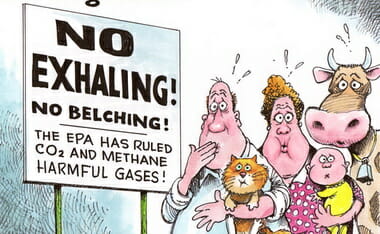Originally posted early 2017
Bottom Line:
- The Mean Global Temperature has been stable since 1997, despite a continuous increase of the CO2 content of the air: how could one say that the increase of the CO2 content of the air is the cause of the increase of the temperature? (discussion: p. 4)
- 57% of the cumulative anthropic emissions since the beginning of the Industrial revolution have been emitted since 1997, but the temperature has been stable. How to uphold that anthropic CO2 emissions (or anthropic cumulative emissions) cause an increase of the Mean Global Temperature?
(more)
Even Michael Mann admits the “pause” in global warming is real!
We Need MORE CO2, Not Less!
Renown physicist Freeman Dyson says CO2 does not worry him… montage
The climate models used by alarmist scientists to predict global warming are getting worse, not better; carbon dioxide does far more good than harm; and President Obama has backed the “wrong side” in the war on “climate change.”
So says one of the world’s greatest theoretical physicists, Dr Freeman Dyson, the British-born, naturalised American citizen who worked at Princeton University as a contemporary of Einstein and has advised the US government on a wide range of scientific and technical issues.
In an interview with Andrew Orlowski of The Register, Dyson expressed his despair at the current scientific obsession with climate change which he says is “not a scientific mystery but a human mystery. How does it happen that a whole generation of scientific experts is blind to the obvious facts.”
This mystery, says Dyson, can only partly be explained in terms of follow the money. Also to blame, he believes, is a kind of collective yearning for apocalyptic doom.
It is true that there’s a large community of people who make their money by scaring the public, so money is certainly involved to some extent, but I don’t think that’s the full explanation.
It’s like a hundred years ago, before World War I, there was this insane craving for doom, which in a way, helped cause World War I. People like the poet Rupert Brooke were glorifying war as an escape from the dullness of modern life. [There was] the feeling we’d gone soft and degenerate, and war would be good for us all. That was in the air leading up to World War I, and in some ways it’s in the air today.
Dyson, himself a longstanding Democrat voter, is especially disappointed by his chosen party’s unscientific stance on the climate change issue.
It’s very sad that in this country, political opinion parted [people’s views on climate change]. I’m 100 per cent Democrat myself, and I like Obama. But he took the wrong side on this issue, and the Republicans took the right side…..
[….]
He concludes:
“I am hoping that the scientists and politicians who have been blindly demonizing carbon dioxide for 37 years will one day open their eyes and look at the evidence.”
- Also read this YALE INTERVIEW of Dr. Dyson
Greenpeace co-founder Dr. Patrick Moore: Human-Induced Global Warming Is a “Complete Fabrication”
- ‘There is some correlation, but little evidence, to support a direct causal relationship between CO2 and global temperature through the millennia. The fact that we had both higher temperatures and an ice age at a time when CO2 emissions were 10 times higher than they are today fundamentally contradicts the certainty that human-caused CO2 emissions are the main cause of global warming.’ (DAILY MAIL)
A Professor of Physics at Princeton University agrees with this summation, that increased CO2 levels are not nearly as harmful as the LEFT makes them out to be:
Dr. William Happer, currently a professor of Physics at Princeton University, was once fired by Gore at the Department of Energy in 1993 for disagreeing with the vice president on the effects of ozone to humans and plant life, also disagrees with Gore’s claim that manmade carbon dioxide (CO2) increases the temperature of the earth and is a threat to mankind. Happer appeared before the U.S. Senate’s Environment and Public Works Committee on Feb. 25 and explained CO2 is in short-supply in relative terms of the history of the planet.
Happer said that when CO2 levels were higher – much higher than they are now, the laws of nature still managed to function as we understand them today.
“The earth was just fine in those times,” Happer said. “You know, we evolved as a species in those times, when CO2 levels were three or four times what they are now. And, the oceans were fine, plants grew, animals grew fine. So it’s baffling to me that, you know, we’re so frightened of getting nowhere close to where we started.”…
(see more at TREE HUGGER).
Must see interview
Here is a quick video which includes 2-minutes from the co-founder of Greenpeace sharing a short soliloquy about why we need more CO2, not less, FOLLOWED by an actual example of plant growth with different CO2 ppms:
Dr. Robert Giegengack, the chair of Department of Earth and Environmental Science at the University of Pennsylvania, has said this in the past. I am merely giving these as examples to counter the “absolute claims” coming from the politicized left (scientists and politicians as well as the media) about CO2.
- In terms of [global warming’s] capacity to cause the human species harm, I don’t think it makes it into the top 10 (source);
- for most of Earth’s history, the globe has been warmer than it has been for the last 200 years. It has rarely been cooler (source);
- [Gore] claims that temperature increases solely because more CO2 in the atmosphere traps the sun’s heat. That’s just wrong … It’s a natural interplay. As temperature rises, CO2 rises, and vice versa [….] It’s hard for us to say that CO2 drives temperature. It’s easier to say temperature drives CO2 (source);
- The driving mechanism is exactly the opposite of what Al Gore claims, both in his film and in that book. It’s the temperature that, through those 650,000 years, controlled the CO2; not the CO2 that controlled the temperature (source).
(Hat-tip to CLIMATE DEPOT)
Can you imagine the polluted, destroyed, world we would have if the left had their way with green energy?
Environazis, like all progressives, care about two things: other people’s money and the power entailed in imposing their ideology. Prominent among the many things they do not care about is the environment, as demonstrated by a monstrosity planned for Loch Ness:
A giant 67 turbine wind farm planned for the mountains overlooking Loch Ness will be an environmental disaster thanks to the sheer quantity of stone which will need to be quarried to construct it, according to the John Muir Trust. In addition, the Trust has warned that the turbines spell ecological disaster for the wet blanket peat-land which covers the area and acts as a huge carbon sink, the Sunday Times has reported.
According to global warming dogma, carbon sinks are crucial in preventing human activity from causing climatic doom.
The planet isn’t the only victim of this ideologically driven enterprise:
Around one million people visit the picturesque Loch Ness, nestled in the highlands of Scotland each year, bringing about £25 million in revenue with them. Most are on the lookout for the infamous monster, but if Scottish and Southern Energy (SSE) get their way the tourists will have something else to look at: the Stronelairg wind farm – 67 turbines, each 443ft high, peppered across the Monadhlaith mountains overlooking the Loch.

Remember what the TWO TOP GOOGLE SCIENTIST in charge of their renewable energy program just said?
We came to the conclusion that even if Google and others had led the way toward a wholesale adoption of renewable energy, that switch would not have resulted in significant reductions of carbon dioxide emissions. Trying to combat climate change exclusively with today’s renewable energy technologies simply won’t work; we need a fundamentally different approach.
[…..]
“Even if one were to electrify all of transport, industry, heating and so on, so much renewable generation and balancing/storage equipment would be needed to power it that astronomical new requirements for steel, concrete, copper, glass, carbon fibre, neodymium, shipping and haulage etc etc would appear. All these things are made using mammoth amounts of energy: far from achieving massive energy savings, which most plans for a renewables future rely on implicitly, we would wind up needing far more energy, which would mean even more vast renewables farms – and even more materials and energy to make and maintain them and so on. The scale of the building would be like nothing ever attempted by the human race.”
But asking someone who has swallowed this story is like beating a dead horse. They will tell me — to my face — that mankind releasing CO2 into the atmosphere is driving weather changes.
I will point out a graph that shows in the past couple of decades man has produced more CO2 combined from the previous 100-years, overlayed to the temperature staying the same for over 18-years (in fact, falling a bit since 2005), and this MAJOR, FOUNDATIONAL belief being shown false doesn’t sway their “belief” towards rethinking their previously held paradigm.

See Also, “Dr. William Happer Speaking To The Benefits Of CO2.”
This comes by way of Gay Patriot, and shows how scientific the party of science is:
Bypassing Congress yet again, Obama today announced a unilateral imposition of carbon dioxide emission limits for electrical power plants.
Even the NYTimes admits the regulations will have no discernible impact on Global CO2 levels. They will, however, cost $50 Billion per year in regulatory costs, raise energy bills an average of $1,200 per family per year, and destroy 224,000 jobs annually through 2030.
The Administration promises none of those outcomes will happen, but then, they also promised “If you like your plan, you can keep your plan,” and “We will be the most transparent administration in history.”
Obama is justifying his dictatorial imposition of carbon dioxide regulations partly on the basis that carbon causes asthma and heart attacks.
You read that right. Carbon. Causes. Asthma.
Party of science my ass.
Climate scientist Dr. Murry Salby, Professor and Climate Chair at Macquarie University, Australia explains in a recent, highly-recommended lecture presented at Helmut Schmidt University, Hamburg, Germany, why man-made CO2 is not the driver of atmospheric CO2 or climate change.
Dr. Salby demonstrates:
- CO2 lags temperature on both short [~1-2 year] and long [~1000 year] time scales
- The IPCC claim that “All of the increases [in CO2 concentrations since pre-industrial times] are caused by human activity” is impossible
- “Man-made emissions of CO2 are clearly not the source of atmospheric CO2 levels”
- Satellite observations show the highest levels of CO2 are present over non-industrialized regions, e.g. the Amazon, not over industrialized regions
- 96% of CO2 emissions are from natural sources, only 4% is man-made
- Net global emissions from all sources correlate almost perfectly with short-term temperature changes [R2=.93] rather than man-made emissions
- Methane levels are also controlled by temperature, not man-made emissions
- Climate model predictions track only a single independent variable – CO2 – and disregard all the other, much more important independent variables including clouds and water vapor.
- The 1% of the global energy budget controlled by CO2 cannot wag the other 99%
- Climate models have been falsified by observations over the past 15+ years
- Climate models have no predictive value
- Feynman’s quote “It doesn’t matter how beautiful your theory is, it doesn’t matter how smart you are. If it doesn’t agree with the data, it’s wrong” applies to the theory of man-made global warming.
See and Read More HERE















